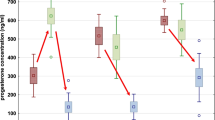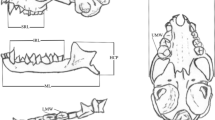Abstract
We studied food intake of and estimated ingested energy in female and male Myotis daubentonii during the periods of pregnancy (period 1, 8 May–4 June) and of intense spermatogenetic activity (period 2, 24 July–22 August) over 8 years (1996–2003) in central Germany. We used radiotelemetry to determine the time spent foraging and marked animals with chemiluminescent light-sticks to determine prey attack rates. Body length, body mass, moisture content, and caloric content of chironomids, the main prey of Daubenton’s bats, were measured to estimate the nightly food intake and, in consequence, energy intake. Pregnant females spent significantly more time foraging than males during period 1 and females during the post-lactation period. In contrast, male foraged longer during the period of highest spermatogenetic activity than during late spring and also significantly longer than post-lactating females. Based on a mean number of 8.3 prey attacks per minute, the time spent foraging, and a capture success rate of either 50 or 92%, calculated intake values with a feeding rate of 7.6 insects per minute (=92% capture success) were more consistent with literature data for other insectivorous bats than that of values calculated on the basis of a capture success rate of 50%. In the high capture-success model, calculated insect intake of female bats was 8.0 g during pregnancy and 4.9 g per day during post-lactation, providing 5.0 and 3.0 kJ of ingested energy per gram body mass per day. Calculated intake of male bats was 3.6 g insects per day during late spring and 8.0 g during period of intensive spermatogenesis, providing 2.6 and 5.7 kJ of ingested energy per gram body mass.

Similar content being viewed by others
References
Anthony ELP (1988) Age determination in bats. In: Kunz TH (ed) Ecological and behavioral methods for the study of bats. Smithsonian Institution, Washington DC, London, pp 1–28
Anthony ELP, Kunz TH (1977) Feeding strategies of the little brown bat, Myotis lucifugus, in southern New Hampshire. Ecology 58:775–786
Barataud M (1992) L’activité crépusculaire et nocturne de 18 espèces de chiroptères, révélée par marquage luminescent et suivi acoustique. Le Rhinolophe 9:23–57
Beck A (1991) Fecal analyses of European bat species. Myotis 32/33:109–119
Belwood JJ, Fenton MB (1976) Variation in the diet of Myotis lucifugus (Chiroptera: Vespertilionidae). Can J Zool 54:1674–1678
Britton ARC, Jones G (1999) Echolocation behaviour and prey-capture success in foraging bats: laboratory and field experiments on Myotis daubentonii. J Exp Biol 202:1793–1801
Buchler ER (1976a) A chemiluminescent tag for tracking bats and other small nocturnal animals. J Mammal 57:173–176
Buchler ER (1976b) Prey selection in Myotis lucifugus (Chiroptera: Vespertilionidae). Am Nat 110:619–628
Cummins KW, Wuycheck JC (1971) Caloric equivalents for investigations in ecological energetics. Mitteilungen der Internationalen Vereinigung für Theoretische und Angewandte Limnologie 18:1–158
De la Noüe J, Choubert G (1985) Apparent digestibility of invertebrate biomasses by rainbow trout. Aquaculture 50:103–112
Dietz M (1998) Habitatansprüche ausgewählter Fledermausarten und mögliche Schutzaspekte. Beitr Akad Natur- und Umweltschutz Baden- Württ 26:27–57
Dietz M, Fitzenräuter B (1996) Zur Flugroutennutzung einer Wasserfledermauspopulation (Myotis daubentoni Kuhl, 1819) im Stadtbereich von Gießen. Säugetierkd Inf 20:107–116
Dietz M, Kalko EKV (2005) Seasonal changes in daily torpor patterns of free-ranging female and male Daubenton’s bats (Myotis daubentonii). J Comp Physiol B 176:223–231
Encarnação JA, Dietz M, Kierdorf U (2002) Zur Mobilität männlicher Wasserfledermäuse (Myotis daubentonii Kuhl, 1819) im Sommer. Myotis 40:19–31
Encarnação JA, Dietz M, Kierdorf U (2004a) Reproductive condition and activity pattern of male Daubenton’s bats (Myotis daubentonii) in the summer habitat. Mamm Biol 69:163–172
Encarnação JA, Dietz M, Kierdorf U, Wolters V (2004b) Body mass changes in male Daubenton’s bats (Myotis daubentonii) during the seasonal activity period. Mammalia 68:291–297
Encarnação JA, Kierdorf U, Holweg D, Jasnoch U, Wolters V (2005) Sex-related differences in roost-site selection of Daubenton’s bats (Myotis daubentonii) during the nursery period. Mamm Rev 35:285–294
Encarnação JA, Kierdorf U, Ekschmitt K, Wolters V (2006) Age-related variation in physical and reproductive condition of male Daubenton’s bats (Myotis daubentonii). J Mammal 87:93–96
Enwistle AC, Racey PA, Speakmann JR (1998) The reproductive cycle and determination of sexual maturity in male brown long-eared bats, Plecotus auritus (Chiroptera: Vespertilionidae). J Zool (London) 244:63–70
Geiger H, Lehnert M, Kallasch C (1996) Zur Alterseinstufung von Wasserfledermäusen (Myotis daubentonii) mit Hilfe des Unterlippenflecks (“chin-spot”). Nyctalus 6:23–28
Gould E (1955) The feeding efficiency of insectivorous bats. J Mammal 36:399–407
Gould E (1959) Further studies on the feeding efficiency of bats. J Mammal 40:149–150
Griffin DR, Webster FA, Michael CR (1960) The echolocation of flying insects by bats. Anim Behav 8:141–154
Jones G, Rayner JMV (1988) Flight performance, foraging tactics and echolocation in free-living Daubenton’s bats, Myotis daubentoni (Chiroptera: Vespertilionidae). J Zool (London) 215:113–132
Kalko E, Braun M (1991) Foraging areas as an important factor in bat conservation: estimated capture attempts and success rate of Myotis daubentonii (Kuhl, 1819). Myotis 29:55–60
Kalko EKV, Schnitzler H-U (1989) The echolocating and hunting behavior of Daubenton’s bat, Myotis daubentoni. Behav Ecol Sociobiol 24:225–238
Kurta A, Bell GP, Nagy KA, Kunz TH (1989) Energetics of pregnancy and lactation in free-ranging little brown bats (Myotis lucifugus). Physiol Zool 62:804–818
McLean JA, Speakman JR (1999) Energy budgets of lactating and non-reproductive brown long-eared bats (Plecotus auritus) suggest females use compensation in lactation. Funct Ecol 13:360–372
Racey PA (1982) Ecology of bat reproduction. In: Kunz TH (ed) Ecology of bats. Plenum, New York, London, pp 57–104
Racey PA (1988) Reproductive assessment in bats. In: Kunz TH (ed) Ecological and behavioral methods for the study of bats. Smithsonian Institution, Washington DC, London, pp 31–45
Racey PA, Speakman JR (1987) The energy costs of pregnancy and lactation in heterothermic bats. Symp Zool Soc Lond 57:107–125
Reynolds DS, Kunz TH (2000) Changes in body composition during reproduction and postnatal growth in the little brown bat, Myotis lucifugus (Chiroptera: Vespertilionidae). Ecoscience 7:10–17
Richardson PW (1994) A new method of distinguishing Daubenton’s bats (Myotis daubentonii) up to one year old from adults. J Zool (London) 233:307–309
Rydell J, McNeill DP, Eklöf J (2002) Capture success of little brown bats (Myotis lucifugus) feeding on mosquitoes. J Zool (London) 256:379–381
Sachs A (1984) Angewandte Statistik, 6th edn. Springer, Berlin Heidelberg New York
Speakman JR, Thomas DW (2003) Physiological ecology and energetics of bats. In: Kunz TH, Fenton MB (eds) Bat ecology. University of Chicago Press, London, pp 430–492
Siemers BM, Stilz P, Schnitzler H-U (2001) The acoustic advantage of hunting at low heights above water: behavioural experiments on the European ‘trawling’ bats Myotis capaccini, M. dasycneme and M. daubentonii. J Exp Biol 204:3843–3854
Sullivan CM, Shiel CB, McAney CM, Fairley JS (1993) Analysis of the diets of Leisler’s Nyctalus leisleri, Daubenton’s Myotis daubentoni and pipistrelle Pipistrellus pipistrellus bats in Ireland. J Zool (London) 231:656–663
Swift SM, Racey PA (1983) Resource partitioning in two species of vespertilionid bats (Chiroptera) occupying the same roost. J Zool (London) 200:249–259
Taake K-H (1992) Strategien der Ressourcennutzung an Waldgewässern jagender Fledermäuse (Chiroptera: Verspertilionidae). Myotis 30:7–94
Vaughan N (1997) The diets of British bats (Chiroptera). Mamm Rev 27:77–94
White GC, Garrott RA (1990) Analysis of wildlife radio-tracking data. Academic, San Diego
Wissing TE, Hassler AD (1971) Interseasonal change in caloric content of some freshwater invertebrates. Ecology 52:371–373
Acknowledgements
We thank our students for assistance during fieldwork over many years. We also thank the bat study groups at the University of Giessen and at the Institute of Animal Ecology and Nature Education of Laubach for their help. We are grateful to Rainer Hutterer, Elisabeth K. V. Kalko, Uwe Kierdorf, Karl V. Miller, and Volkmar Wolters for helpful comments on the manuscript. The study was performed in compliance with the current animal care and nature conservation laws of Germany and approved by the nature conservation authority of the administrative district of Giessen, federal state of Hesse.
Author information
Authors and Affiliations
Corresponding author
Rights and permissions
About this article
Cite this article
Encarnação, J.A., Dietz, M. Estimation of food intake and ingested energy in Daubenton’s bats (Myotis daubentonii) during pregnancy and spermatogenesis. Eur J Wildl Res 52, 221–227 (2006). https://doi.org/10.1007/s10344-006-0046-2
Received:
Accepted:
Published:
Issue Date:
DOI: https://doi.org/10.1007/s10344-006-0046-2




